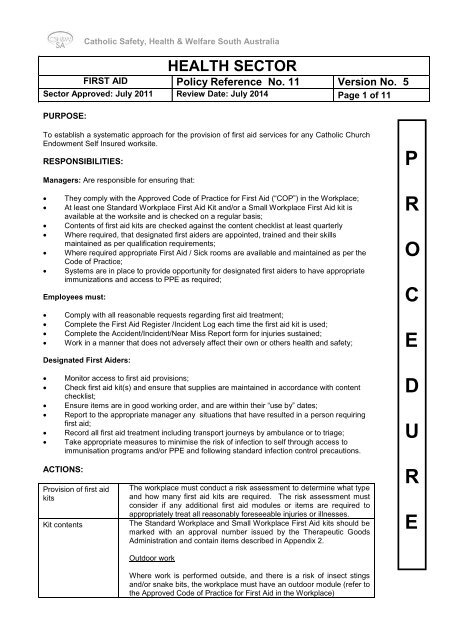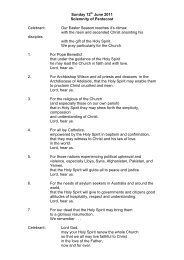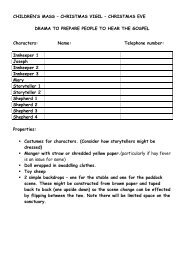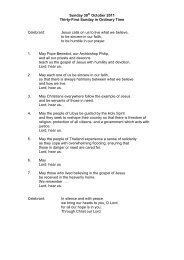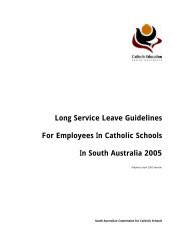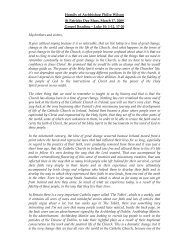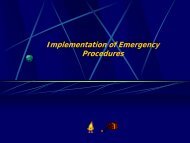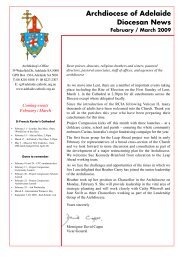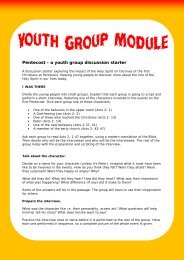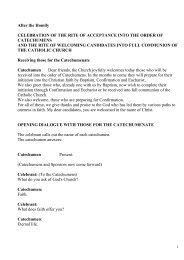11 FIRST AID V5 - (298.7kB)
11 FIRST AID V5 - (298.7kB)
11 FIRST AID V5 - (298.7kB)
You also want an ePaper? Increase the reach of your titles
YUMPU automatically turns print PDFs into web optimized ePapers that Google loves.
Catholic Safety, Health & Welfare South Australia<br />
HEALTH SECTOR<br />
<strong>FIRST</strong> <strong>AID</strong> Policy Reference No. <strong>11</strong> Version No. 5<br />
Sector Approved: July 20<strong>11</strong> Review Date: July 2014 Page 1 of <strong>11</strong><br />
PURPOSE:<br />
To establish a systematic approach for the provision of first aid services for any Catholic Church<br />
Endowment Self Insured worksite.<br />
RESPONSIBILITIES:<br />
Managers: Are responsible for ensuring that:<br />
<br />
<br />
<br />
<br />
<br />
<br />
They comply with the Approved Code of Practice for First Aid (“COP”) in the Workplace;<br />
At least one Standard Workplace First Aid Kit and/or a Small Workplace First Aid kit is<br />
available at the worksite and is checked on a regular basis;<br />
Contents of first aid kits are checked against the content checklist at least quarterly<br />
Where required, that designated first aiders are appointed, trained and their skills<br />
maintained as per qualification requirements;<br />
Where required appropriate First Aid / Sick rooms are available and maintained as per the<br />
Code of Practice;<br />
Systems are in place to provide opportunity for designated first aiders to have appropriate<br />
immunizations and access to PPE as required;<br />
Employees must:<br />
<br />
<br />
<br />
<br />
Comply with all reasonable requests regarding first aid treatment;<br />
Complete the First Aid Register /Incident Log each time the first aid kit is used;<br />
Complete the Accident/Incident/Near Miss Report form for injuries sustained;<br />
Work in a manner that does not adversely affect their own or others health and safety;<br />
Designated First Aiders:<br />
<br />
<br />
<br />
<br />
<br />
<br />
Monitor access to first aid provisions;<br />
Check first aid kit(s) and ensure that supplies are maintained in accordance with content<br />
checklist;<br />
Ensure items are in good working order, and are within their “use by” dates;<br />
Report to the appropriate manager any situations that have resulted in a person requiring<br />
first aid;<br />
Record all first aid treatment including transport journeys by ambulance or to triage;<br />
Take appropriate measures to minimise the risk of infection to self through access to<br />
immunisation programs and/or PPE and following standard infection control precautions.<br />
ACTIONS:<br />
Provision of first aid<br />
kits<br />
Kit contents<br />
The workplace must conduct a risk assessment to determine what type<br />
and how many first aid kits are required. The risk assessment must<br />
consider if any additional first aid modules or items are required to<br />
appropriately treat all reasonably foreseeable injuries or illnesses.<br />
The Standard Workplace and Small Workplace First Aid kits should be<br />
marked with an approval number issued by the Therapeutic Goods<br />
Administration and contain items described in Appendix 2.<br />
P<br />
R<br />
O<br />
C<br />
E<br />
D<br />
U<br />
R<br />
E<br />
Outdoor work<br />
Where work is performed outside, and there is a risk of insect stings<br />
and/or snake bits, the workplace must have an outdoor module (refer to<br />
the Approved Code of Practice for First Aid in the Workplace)
Catholic Safety, Health & Welfare South Australia<br />
<strong>FIRST</strong> <strong>AID</strong> No. <strong>11</strong> Version No. 5 Page 2 of <strong>11</strong><br />
Design of First Aid<br />
Kits<br />
Location of First Aid<br />
kits<br />
Maintenance of First<br />
Aid Kits<br />
Other first aid<br />
facilities (First Aid<br />
Rooms / Sick<br />
Rooms)<br />
Remote Work<br />
There is an increased risk of serious injury when work is performed in<br />
remote location because of potential delays in getting access to<br />
ambulance and emergency departments. If work is to be performed in<br />
remote locations, a risk assessment must be done to determine if:<br />
a. Other types of first aid items are required (i.e. additional to the<br />
Standard or Small Workplace kits); and/or<br />
b. If more than the minimum number of items already specific for the<br />
kits should be provided, for example extra:<br />
i. Sachets of hydro gel;<br />
ii. BPC wound dressing (for serious bleeds); and/or<br />
iii. Emergency rescue blankets<br />
First aid kits may be of any size, shape or type, but each kit should:<br />
a. Be large enough to house all required contents and be able to be<br />
securely closed;<br />
b. Contain a list of the required contents;<br />
c. Have a white cross on green background prominently displayed<br />
on the outside;<br />
d. Be made of material that will protect the contents from dust,<br />
moisture and contamination; and<br />
e. Be portable (with exception of first aid supplies kept in first aid<br />
room)<br />
Kits should be located in a readily accessible area and should not<br />
take more than 4 minutes to retrieve to treat a seriously ill/injured<br />
person.<br />
Location of first aid kits in fixed workplaces should be identified with<br />
suitable signage that is compliant with AS 1319: 1994 – Safety Signs<br />
for the Occupational Environment<br />
A first aid kit in a mobile workplace should be easily accessible and<br />
safely located so as not to become a projective in the event of an<br />
accident. In mobile workplaces (e.g. cars and buses) the location of<br />
a first aid kit should be identified by a prominent sticker on the vehicle<br />
that either marks the location of the kit, or explains where it is.<br />
A person designated with the duty to provide first aid should be<br />
allocated responsibility for maintenance of the kits.<br />
First aid kits are to be checked at least quarterly. Form <strong>11</strong>b can be<br />
used.<br />
In addition to appropriate first aid kits, workplaces may need to<br />
consider additional first aid facilities to treat reasonably foreseeable<br />
work-related injuries e.g. automatic defibrillators.<br />
First aid rooms should be provided in any workplace that meets the<br />
requirements as identified in the COP section 2.18. Workplaces must<br />
also take into account factor peculiar to that workplace to determine if<br />
a first aid room is required (e.g. schools: children require treatment).<br />
If a first aid room or occupational health service is not provided, a rest<br />
areas must be provided or suitable administrative arrangements must<br />
be made to ensure the wellbeing of a person who becomes sick while<br />
at work.<br />
Refer to section 2.21 of the COP of what First Aid Rooms should<br />
contain.<br />
A first aid room should:<br />
a. Be suitably located and be easily accessible to emergency<br />
services;<br />
b. Be well lit and ventilated;<br />
P<br />
R<br />
O<br />
C<br />
E<br />
D<br />
U<br />
R<br />
E
Catholic Safety, Health & Welfare South Australia<br />
<strong>FIRST</strong> <strong>AID</strong> No. <strong>11</strong> Version No. 5 Page 3 of <strong>11</strong><br />
Designated First<br />
Aiders<br />
Training<br />
requirements<br />
Numbers required<br />
Management of<br />
Critical Incidents<br />
Reporting<br />
TRAINING:<br />
c. Be readily accessible to toilet facilities;<br />
d. Have an appropriate floors area (14 square metres as a guide);<br />
and<br />
e. Have an entrance clearly marked “<strong>FIRST</strong> <strong>AID</strong>”.<br />
The 4 types of designated first aiders permitted under the COP are<br />
distinguished by the level of training they receive. Refer to definitions<br />
section.<br />
Designated first aiders must hold nationally recognised Statement/s<br />
of Attainment issued by a Registered Training Organisation.<br />
The workplace needs to ensure that there are an appropriate number<br />
of designated first aiders available by following the five-step process<br />
outlined in Section 3.6 of the COP.<br />
Every workplace must have in place arrangements and procedures<br />
for the appropriate management of any reasonably foreseeable<br />
critical incidents that may occur at the workplace.<br />
Refer to Document 2: Accident/Incident and Near Miss Reporting<br />
And Document 10: Emergency and Critical Incident<br />
Whenever treatment is provided, it must be recorded on the First Aid<br />
Register (Form No. <strong>11</strong>c). The First Aid Register must be reviewed at 3<br />
monthly intervals.<br />
NB: Where separate first aid records are kept for students, they too must<br />
be reviewed to assist in the identification of any hazards that need to be<br />
risk assessed.<br />
All employees will be informed in the requirements of this procedure during their induction<br />
process.<br />
Those persons with roles and responsibilities for the provision of first aid services will be provided<br />
with specific information, instruction and training in line with their specific role and/or<br />
responsibilities.<br />
Training for designated first aiders must be in line with the requirements outlined in the Approved<br />
Code of Practice for First Aid and must be delivered by one of the approved South Australian<br />
based training providers listed on SafeWork SA’s website.<br />
MONITOR & REVIEW:<br />
This procedure will be monitored for compliance and effectiveness. The document will be subject<br />
to review within a three year period of the date of issue or at any time pursuant to either<br />
legislative or CCES Policy change, or as required by any other change in associated legislation.<br />
Refer to Form <strong>11</strong>a for targets and performance measures.<br />
RELATED DOCUMENTS:<br />
Occupational Health, Safety and Welfare Act 1986<br />
Occupational Health, Safety and Welfare Regulations 2010 Division <strong>11</strong><br />
Approved Code of Practice for First Aid in the Workplace<br />
AS 1319: 1994 – Safety Signs for the Occupational Environment<br />
CCSM Document 2: Accident / Incident / Near Miss Reporting Procedure<br />
CCSM Document 10: Emergency Management / Critical Incident Procedure<br />
CCSM Document 14: Hazard Management Procedure<br />
P<br />
R<br />
O<br />
C<br />
E<br />
D<br />
U<br />
R<br />
E<br />
APPENDICES<br />
Appendix 1 Definitions<br />
Appendix 2 Table 1: Minimum Contents for First Aid Kits
Catholic Safety, Health & Welfare South Australia<br />
<strong>FIRST</strong> <strong>AID</strong> No. <strong>11</strong> Version No. 5 Page 4 of <strong>11</strong><br />
FORMS<br />
Form <strong>11</strong>a:<br />
Form <strong>11</strong>b:<br />
Form <strong>11</strong>c:<br />
Procedure verification checklist<br />
First Aid Kit Register<br />
First Aid Register<br />
P<br />
R<br />
O<br />
C<br />
E<br />
D<br />
U<br />
R<br />
E
Catholic Safety, Health & Welfare South Australia<br />
HEALTH SECTOR<br />
<strong>FIRST</strong> <strong>AID</strong> Policy Reference No. <strong>11</strong> Version No. 5<br />
Sector Approved: July 20<strong>11</strong> Review Date: July 2014 Page 5 of <strong>11</strong><br />
DEFINITIONS:<br />
COP<br />
Designated first<br />
aider<br />
APPENDIX No: 1<br />
Approved Code of Practice for First Aid in the Workplace<br />
A person with the designated duty to provide first aid in the workplace how:<br />
(a) Has attended training and has as a result an appropriate and current statement/s of<br />
attainment; or<br />
(b) Is an appropriate health professional<br />
4 Types of designated first aiders are defined as follows:<br />
a) “Basic First Aider” meaning a person who has successfully completed a recognised<br />
training course that has given them the competencies required to recognise and<br />
respond to common life-threatening injuries or illnesses using (as appropriate):<br />
<br />
<br />
Cardio-pulmonary resuscitation (CPR); and/or<br />
Other appropriate first aid procedures.<br />
b) “Senior First Aider” meaning a person who has successfully complete a recognised<br />
training course that has given them the competencies required to:<br />
<br />
<br />
Recognize and respond to common life-threatening injuries or illnesses using<br />
(as appropriate) cardio-pulmonary resuscitation (CPR) and/or other<br />
appropriate first aid procedures; and<br />
Provide appropriate first aid for a broader range of injuries and illnesses.<br />
c) “Occupational First Aider” meaning a person who has successfully completed a<br />
recognised training course that has given them the competencies required to:<br />
<br />
<br />
<br />
Recognize and respond to common life-threatening injuries or illnesses using<br />
(as appropriate) cardio-pulmonary resuscitation (CPR) and/or other<br />
appropriate first aid procedures; and<br />
Provide appropriate first aid for a broader range of injuries and illnesses; and<br />
Manage a first aid room.<br />
d) “Remote First Aider” meaning a Senior First Aider who has also successfully<br />
completed a recognised training course that has given them competencies required to:<br />
Health<br />
professional<br />
First Aid<br />
First Aid<br />
Facilities<br />
<br />
<br />
<br />
Recognize and respond to common life-threatening injuries or illnesses using<br />
(as appropriate) cardio-pulmonary resuscitation (CPR) and/or other<br />
appropriate first aid procedures;<br />
Provide appropriate first aid for a broader range of injuries and illnesses; and<br />
provide first aid to a casualty in a remote and/or isolated situation including<br />
preparing for aero-medical evacuation.<br />
(a) An appropriately qualified paramedic as recognized by the SA Ambulance Service; or<br />
(b) A doctor registered with the Medical Board of South Australia; or<br />
(c) An occupational health nurse or registered nurse who has current registration with the<br />
appropriate professional body<br />
Is the immediate treatment or care given to someone suffering from an injury or illness until<br />
more advanced care is accessed or they recover.<br />
Physical resources provided at a workplace to ensure the timely provision of appropriate first<br />
aid to a person who suffers an injury or illness while at the workplace. The most common type<br />
of facility is a first aid kit but in high risk workplaces other facilities may include:
Catholic Safety, Health & Welfare South Australia<br />
<strong>FIRST</strong> <strong>AID</strong> No. <strong>11</strong> Version No. 5 Page 6 of <strong>11</strong><br />
Remote<br />
RTO<br />
Workplace<br />
a) Deluge facility;<br />
b) Automated external defibrillator<br />
c) Oxygen equipment;<br />
d) First aid rooms; or<br />
e) Occupational health services.<br />
A Workplace that is more than a 20 minute drive away from:<br />
a) An SA ambulance station that is staffed by paid paramedics;<br />
b) or an occupational health service capable of mounting an emergency response; or<br />
c) A hospital or medical centre capable of mounting an emergency response.<br />
Registered Training Organisation<br />
Any place (including any aircraft, ship or vehicle) where an employee or self-employed person<br />
works and includes any place where such a person goes while at work.
Catholic Safety, Health & Welfare South Australia<br />
HEALTH SECTOR<br />
<strong>FIRST</strong> <strong>AID</strong> Policy Reference No. <strong>11</strong> Version No. 5<br />
Sector Approved: July 20<strong>11</strong> Review Date: July 2014 Page 7 of <strong>11</strong><br />
APPENDIX No: 2
Catholic Safety, Health & Welfare South Australia<br />
<strong>FIRST</strong> <strong>AID</strong> No. <strong>11</strong> Version No. 5 Page 8 of <strong>11</strong>
Catholic Safety, Health & Welfare South Australia<br />
HEALTH SECTOR<br />
<strong>FIRST</strong> <strong>AID</strong> Policy Reference No. <strong>11</strong> Form No: <strong>11</strong>a<br />
Sector Approved: July 20<strong>11</strong> Review Date: July 2014 Page 1 of 1<br />
PROCEDURE VERIFICATION<br />
TARGET<br />
A risk assessment has<br />
been completed to<br />
determine what First Aid<br />
Kits are required<br />
Induction of all new<br />
employees (within last 12<br />
months) have been<br />
informed about how to<br />
access first aid<br />
SECTOR SPECIFIC<br />
100% of first aid kits are<br />
stocked in accordance with<br />
the kit type or the minimum<br />
contents list<br />
Workplace has at least one<br />
designated first aider<br />
appointed<br />
100% of designated first<br />
aiders appropriately trained<br />
100% of first aid rooms<br />
have appropriate signage<br />
MEASUREMENT<br />
Documented risk assessment<br />
OHS Committee Minutes<br />
Induction records<br />
Training records<br />
RESULT<br />
SCORE<br />
ACTIONS<br />
Each sector is to determine what targets are applicable from list below. May<br />
develop their own<br />
First aid kits checked quarterly and<br />
records maintained<br />
Names of designated first aiders<br />
clearly displayed throughout the<br />
workplace (on noticeboards and/or<br />
in first aid rooms, on first aid kits)<br />
Check training records to verify<br />
designated first aiders have<br />
attended appropriate training with<br />
an RTO and that records are<br />
current.<br />
Check that there are signs<br />
displayed<br />
TOTAL<br />
Each verification question is scored out of 1.<br />
If the target is being met to indicate that the procedure is in place and being complied with then a score of<br />
one (1) is obtained, if not the score is 0 and corrective action is implemented unless it is not applicable.<br />
Record completed procedure verification on Audit Tracking Tool (Form 7b).<br />
Verification completed by:<br />
Signature: ............................................................<br />
Name: ............................................................ Date: ........................................<br />
Manager:<br />
Signature: ............................................................<br />
Name: ............................................................ Date: ........................................<br />
Page 9 of <strong>11</strong>
Catholic Safety, Health & Welfare South Australia<br />
HEALTH SECTOR<br />
<strong>FIRST</strong> <strong>AID</strong> Policy Reference No. <strong>11</strong> Form No.: <strong>11</strong>b<br />
Sector Approved: July 20<strong>11</strong> Review Date: July 2014 Page 1 of 1<br />
<strong>FIRST</strong><strong>AID</strong> KIT REGISTER<br />
SITE: LOCATION: YEAR: / /<br />
Identify First Aid Room / Kit<br />
locations<br />
E.g. First Aid Room<br />
Classroom 1<br />
Staff room<br />
Contents of First Aid Kit Checked (Record date & initial or attach form if using external provider)<br />
Quarter 1 Quarter 2 Quarter 3 Quarter 4<br />
Page 10 of <strong>11</strong>
Catholic Safety, Health & Welfare South Australia<br />
HEALTH SECTOR<br />
<strong>FIRST</strong> <strong>AID</strong> Policy Reference No. <strong>11</strong> Form No. <strong>11</strong>c<br />
Sector Approved: July 20<strong>11</strong> Review Date: July 2014 Page 1 of 1<br />
<strong>FIRST</strong> <strong>AID</strong> REGISTER<br />
Date<br />
Name / Location of<br />
Injured Person<br />
Nature of Injury<br />
(eg cut, burn)<br />
First aid treatment<br />
given<br />
Signature<br />
Hazard Report<br />
Form completed<br />
(if applicable)<br />
Yes No <br />
Hazard<br />
Register<br />
Updated<br />
Dates report reviewed: ………………………………………………………….…………………………………………………………….<br />
By Whom: …………….…………………………………………………………………………………………………………………………<br />
`Page <strong>11</strong> of <strong>11</strong>


